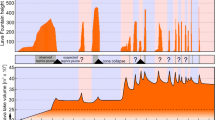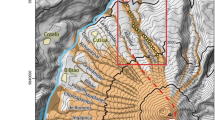Abstract
The asymmetrical distribution of the welded Ata large-scale pyroclastic flow deposit in Southern Kyushu, Japan was identified. This distribution pattern was defined as depositional ramps. Depositional ramps can be identified in valleys wider than 1 km and become smaller-scale with increasing distance from the source. Upslope directions of depositional ramps are generally radially away from the source caldera, suggesting that the structure was formed by the flow of pyroclastic material radially away from the source. The original depositional surface was reconstructed based on field mapping and density measurements of the pyroclastic flow deposit. Depositional ramps having a dip angle of more than 9° were reconstructed on the vent-facing slopes of the topography underlying the valley-filling deposits in the area within 10 km of the caldera rim. Such a dip angle is much larger than previously described dip angles. The size and gradient of the depositional ramps decreases with increasing distance from the source. Depositional ramps are recognized commonly in densely welded pyroclastic flow deposits. A high emplacement temperature is required to form the depositional ramps. This suggests that the pyroclastic flow was transported as a dense, fluidized layer to minimize heat loss.
Similar content being viewed by others
References
Aramaki S, Ui T (1966) Aira and Ata pyroclastic flows and related caldera depressions in southern Kyushu, Japan. Bull Volcanol 29:29–48
Boyd FR (1961) Welded tuffs and flows in the rhyolite plateau of Yellowstone Park. Wyoming. Geol Soc Am Bull 72:387–426
Chapin CE, Lowell GR (1979) Primary and secondary flow structures in ash flow tuffs of the Gribbles Run paleovally, central Colorado. In: Chapin CE, Elston WE (eds). Ash-Flow Tuffs. Geol Soc Am Spec Pap 180:137–154
Hayasaka S (1982) Kagoshima Bay as a graben structure: Reports on the basement formations and graben structures in Kyushu 1:76–78 (in Japanese)
Machida H, Arai F (1983) Late Pleistocene widespread tephra from Kikai caldera; new units and revision of age estimates on several large-scale pyroclastic flow deposits in Kyushu. Bull Volcanol Soc Japan 2nd ser 28:206 (in Japanese)
Minato M, Hashimoto S, Fujiwara Y, Kumano S, Okada S (1972) Stratigraphy of the Quaternary ash and pumiceous products in southwestern Hokkaido. N. Japan. J Fac Sci Hokkaido Univ 35:679–736
Ono K, Watanabe K (1974) Secondary flowage in Aso-2 pyroclastic flow deposit around the west rim of the Aso caldera, central Kyushu. Bull Volcanol Soc Japan 2nd ser 19:93–110 (in Japanese with English abstr)
Ross CS, Smith RL (1961) Ash-flow tuffs: Their origin, geologic relations, and identification. U S Geol Surv Prof. Pap 366:81p
Saito M, Kambe N, Katada M (1958) Expranatory text of 1:50000 geologic quardrangle map Mitai 77p Geol Surv Japan
Sakaguchi K (1981) Geology of the Tashiro pyroclastic flow deposit distributed in Ohsumi Peninsula. Kagoshima Prefecture: Mas Thesis Kobe Univ 42p (in Japanese with English abstract) (MS)
Sheridan MF (1979) Emplacement of pyroclastic flows: A review. In Chapin CE, Elston WE (eds) Ash-Flow Tuffs Geol Soc Amer Spec Pap 180:125–136
Shibata K (1978) Contemporaneity of Tertiary granites in the Outer Zone of southwest Japan. Bull Geol Surv Japan 29:551–554 (in Japanese with English abstr)
Suzuki K (1983) Flow and emplacement mechanisms of a large-scale pyroclastic flow. Ph D Thesis of Kobe Univ (MS)
Suzuki K, Ui T (1982) Grain orientation and depositional ramps as flow direction indicators of a large-scale pyroclastic flow deposit in Japan. Geology 10:429–432
Suzuki K, Ui T (1983) Factors governing the flow lineation of a large-scale pyroclastic flow — An example in the Ata pyroclastic flow deposit, Japan. Bull Volcanol 46:71–81
Ui T (1971) Pyroclastic rocks along the south coast of Kagoshima Bay, part 1 Stratigraphy and character of pyroclastic deposit at the middle part of Osumi Peninsula.Abstracts 1971 Ann Meeting of the Geol Soc Japan:316 (in Japanese)
Ui T, Suzuki K, Sakaguchi K, Tokunaga K (1983) Calderas and pyroclastic flows at the middle and south part of Kagoshima Bay. he Earth Monthly 5:110–115 (in Japanese)
Wilson L, Head LW (1981) Morphology and rheology of pyroclastic flows and their deposits, and guidelines for future observations. In: Lipman PW, Mullineaux DR (eds) US Geol Surv Prof Pap 1250:513–524
Wolff JA, Wright JV (1981) Rheomorphism of welded tuffs. J Volcanol Geotherm Res 10:13–34
Yokoyama S (1974) Flow and emplacement mechanism of the Ito pyroclastic flow from Aira caldera, Japan. Tokyo Kyoiku Daigaku Sci Rept Sec C 12:1–62
Author information
Authors and Affiliations
Rights and permissions
About this article
Cite this article
Suzuki-Kamata, K., Ui, T. Depositional ramps: asymmetrical distribution structure in the Ata pyroclastic flow deposit, Japan. Bull Volcanol 50, 26–34 (1988). https://doi.org/10.1007/BF01047506
Received:
Accepted:
Issue Date:
DOI: https://doi.org/10.1007/BF01047506




